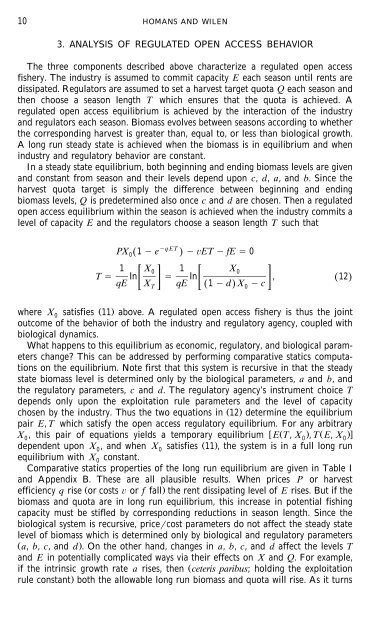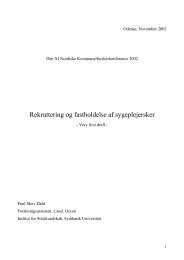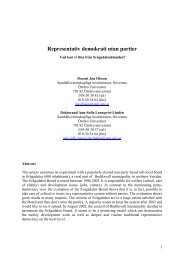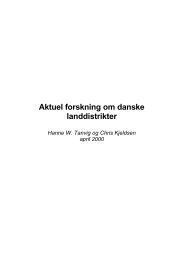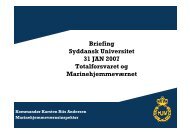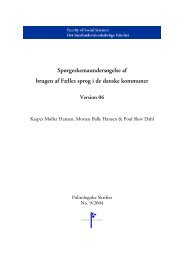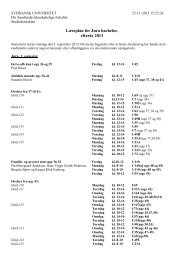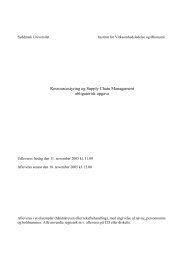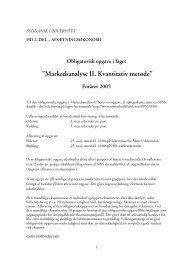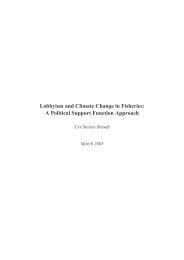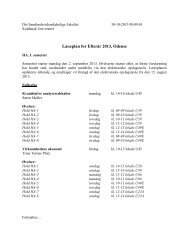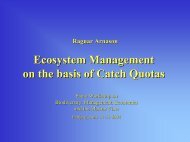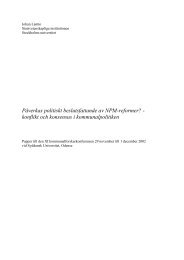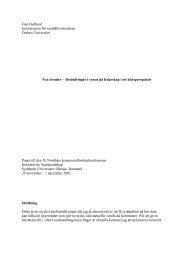A Model of Regulated Open Access Resource Use
A Model of Regulated Open Access Resource Use
A Model of Regulated Open Access Resource Use
Create successful ePaper yourself
Turn your PDF publications into a flip-book with our unique Google optimized e-Paper software.
10<br />
HOMANS AND WILEN<br />
3. ANALYSIS OF REGULATED OPEN ACCESS BEHAVIOR<br />
The three components described above characterize a regulated open access<br />
fishery. The industry is assumed to commit capacity E each season until rents are<br />
dissipated. Regulators are assumed to set a harvest target quota Q each season and<br />
then choose a season length T which ensures that the quota is achieved. A<br />
regulated open access equilibrium is achieved by the interaction <strong>of</strong> the industry<br />
and regulators each season. Biomass evolves between seasons according to whether<br />
the corresponding harvest is greater than, equal to, or less than biological growth.<br />
A long run steady state is achieved when the biomass is in equilibrium and when<br />
industry and regulatory behavior are constant.<br />
In a steady state equilibrium, both beginning and ending biomass levels are given<br />
and constant from season and their levels depend upon c, d, a, and b. Since the<br />
harvest quota target is simply the difference between beginning and ending<br />
biomass levels, Q is predetermined also once c and d are chosen. Then a regulated<br />
open access equilibrium within the season is achieved when the industry commits a<br />
level <strong>of</strong> capacity E and the regulators choose a season length T such that<br />
PX0Ž 1 e qET . ET fE 0<br />
1 X0 1 X0<br />
T ln ln , Ž 12.<br />
qE X qE Ž 1 d.<br />
X c<br />
T 0<br />
where X satisfies Ž 11.<br />
0<br />
above. A regulated open access fishery is thus the joint<br />
outcome <strong>of</strong> the behavior <strong>of</strong> both the industry and regulatory agency, coupled with<br />
biological dynamics.<br />
What happens to this equilibrium as economic, regulatory, and biological parameters<br />
change? This can be addressed by performing comparative statics computations<br />
on the equilibrium. Note first that this system is recursive in that the steady<br />
state biomass level is determined only by the biological parameters, a and b, and<br />
the regulatory parameters, c and d. The regulatory agency’s instrument choice T<br />
depends only upon the exploitation rule parameters and the level <strong>of</strong> capacity<br />
chosen by the industry. Thus the two equations in Ž 12.<br />
determine the equilibrium<br />
pair E, T which satisfy the open access regulatory equilibrium. For any arbitrary<br />
X , this pair <strong>of</strong> equations yields a temporary equilibrium ET,X Ž .,TŽ E, X .<br />
0 0 0<br />
dependent upon X , and when X satisfies Ž 11 .<br />
0 0<br />
, the system is in a full long run<br />
equilibrium with X0<br />
constant.<br />
Comparative statics properties <strong>of</strong> the long run equilibrium are given in Table I<br />
and Appendix B. These are all plausible results. When prices P or harvest<br />
efficiency q rise Ž or costs or f fall.<br />
the rent dissipating level <strong>of</strong> E rises. But if the<br />
biomass and quota are in long run equilibrium, this increase in potential fishing<br />
capacity must be stifled by corresponding reductions in season length. Since the<br />
biological system is recursive, pricecost parameters do not affect the steady state<br />
level <strong>of</strong> biomass which is determined only by biological and regulatory parameters<br />
Ž a, b, c, and d .. On the other hand, changes in a, b, c, and d affect the levels T<br />
and E in potentially complicated ways via their effects on X and Q. For example,<br />
if the intrinsic growth rate a rises, then Žceteris paribus; holding the exploitation<br />
rule constant.<br />
both the allowable long run biomass and quota will rise. As it turns


